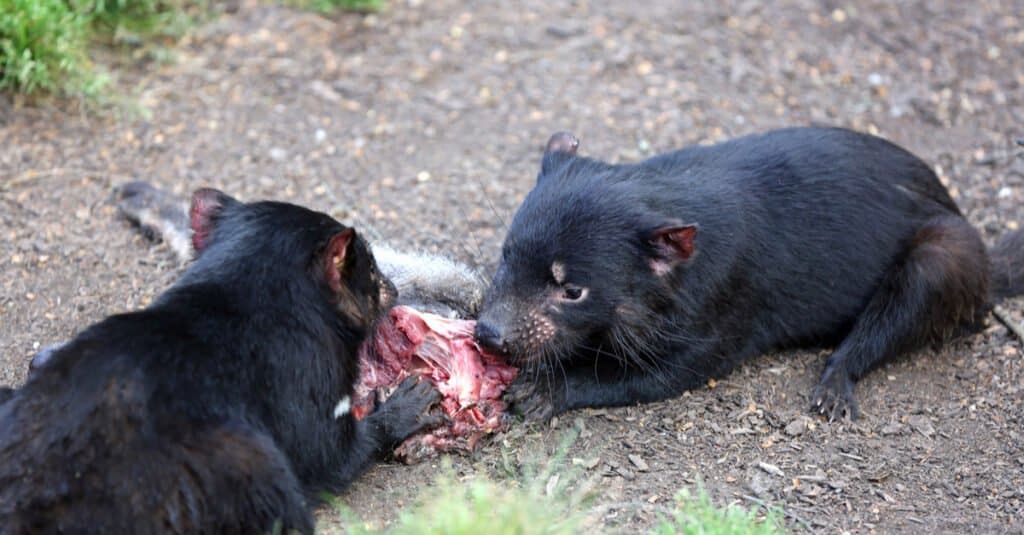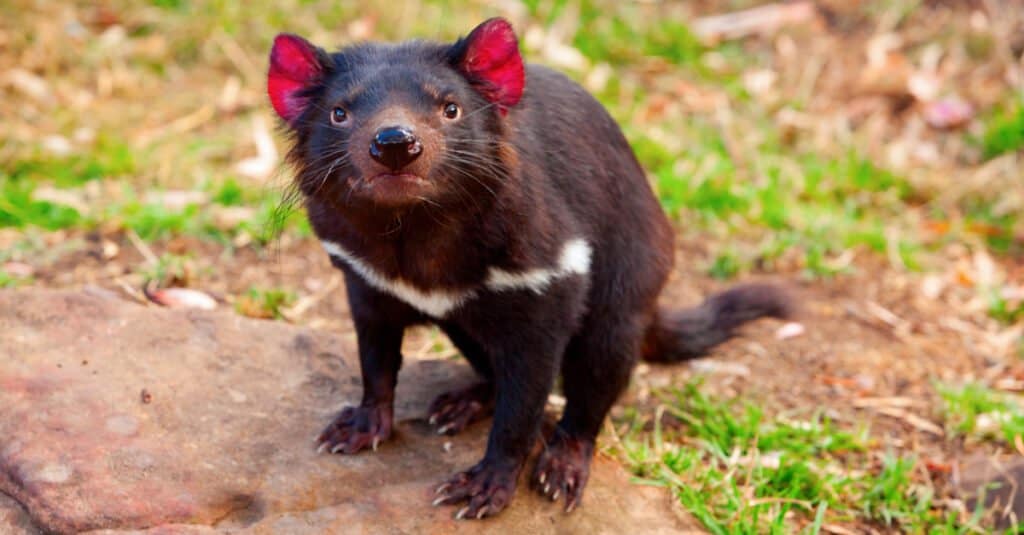If you have spent most, or at least half, of your childhood watching cartoons, then you must have probably come across Taz from Looney Tunes at some point. However, he is not just a made-up character. Taz, a quite endearing and notorious cartoon character, was designed after a Tasmanian devil, one of the most unusual mammals that inhabits the island of Tasmania in Australia. Tasmanian devils are also marsupials, relating them to kangaroos and koalas. These marsupials are once settling throughout mainland Australia, as seen in fossils from about 3,000 years ago.
You might be thinking, who would give them such a feisty name if they are no bigger than the size of a tiny dog? Well, as it turns out, Tasmanian devils are fiercer than they look. They are widely known to fly into a rage whenever frightened or protecting meat and other carcasses. Tasmanian devils are portrayed to be snarly, often showcasing their teeth-baring, spine-chilling growls. But each fierce snarl and high-pitched scream signifies their goal to establish dominance over a carrion or prey they are feeding themselves with. Which raises the questions: What do Tasmanian Devils eat? Do they hunt for their prey? And do they feed on people?
What Do Tasmanian Devils Eat?

Tasmanian devils eat frogs, birds, fish, and insects.
©james_stone76/Shutterstock.com
Taz, as portrayed in the animated show, has a ravenous appetite, and he munches on other mammals such as rabbits. Similarly in real life, Tasmanian devils are indeed carnivorous.
Tasmanian devils are carnivores that eat a wide range of other living animals such as frogs, fish, and insects. Their full diet includes:
- Frogs
- Birds
- Fish
- Insects and other invertebrate
- Wombats
- Rabbits
- Squirrels
- Macropods such as wallabies and possums
Apart from hunting for their prey, these marsupials also love to scavenge for their food. As nocturnals and antisocials, devils prefer to stay hidden during the day. They burrow themselves in tunnels, hollow logs, under stones, or caves, and emerge at night to eat or hunt for prey. With their long whiskers, they are able to evade predators and locate prey or carrion. There is nothing these creatures won’t eat, and when they do, they are voracious eaters who gobble up everything they come across, including hair, organs, and bone fragments. With their large heads and hefty bodies, Tasmanian devils look slow and awkward as they amble along, but they are Tasmania’s most ferocious predators. Having powerful jaws and tearing teeth, devils are able to eat the entire cadaver, including the bones.
How Do Tasmanian Devils Hunt and Eat their Prey?
Tasmanian devils often eat carrion together in groups. When fighting for position on a large carcass, they are at their most raucous. There is a lot of growling and screeching when they gather together to eat carcasses, which is where most of the noise comes from. They’re known as gorge eaters too, because they eat loads of food at once. The tails of these marsupials, like those of other mammals, swell with fat when they are well-fed.
They are also dubbed as the “Australian hyena” because of their intrusive scavenging habits and their bone-crushing bites. When not scavenging, these mammals can finish their living prey with powerful bites on the head, neck, or chest.
How Much Do Tasmanian Devils Eat?

Tasmanian devils eat every 3-8 days on average
©Bernhard Richter/Shutterstock.com
Tasmanian devils eat every 3-8 days on average, and an adult devil with 22 pounds (10 kg) of body weight can eat up to 2.2 pounds (1kg ) of food per day on average. As observed in Pemberton and Renouf’s A field study of communication and social behaviour of the Tasmanian devil at feeding sites in 1993, they are observed to consume around 2.4 kg or 5.3 lbs of carcass in one feeding session that lasts about 34 minutes on average. These marsupials can fill up their tummies up to 40% of their own body weight in one meal session, especially if they don’t know where or when they will get their next meal.
What Eats Tasmanian Devils?
Before they had gone extinct in the other parts of Australia, there are possibilities that thylacines or Tasmanian tigers have hunted them. Thylacines are large marsupials that used to inhabit parts of Australia, Tasmania, and New Guinea. Eagles and other large birds of prey such as owls may attack young devils as they emerge from their burrows during the day. Young devils may be attacked by large quolls at night as well. Large devils may even eat smaller devils if they are starving enough, and young devils climb so well in order to evade larger devils.
Are Tasmanian Devils Dangerous to People?

While carnivores, Tasmanian devils are not harmful to people
©Oleksii G/Shutterstock.com
Tasmanian devils are generally not dangerous to people. While their teeth can be sharp, their preference is to evade humans. If provoked, they can attack and cause harm to humans. If a Tasmanian devil is threatened it will let out a sound that is similar to a “yawn” that signals fear.
The short story is, as long as you don’t act aggressively or trap a Tasmanian devil, it’s very unlikely they’ll be harmful!
How are Tasmanian Devils Useful for the Environment?
Even though devils are known to feed on decayed meat, their presence in the environment provides a huge benefit by scavenging on sick or dead animals. Tasmanian devils can help control animals that don’t belong in Tasmania, such as the Australian mainland’s red fox. While Tasmania is home to many devils, foxes have a difficult time raising their young. Devils can easily detect fox dens because they are foul-smelling and disorganized. Apart from this, the Tasmanian devil is probably the first thing that comes to mind when you think of things that are unique to Tasmania. These marsupials are a popular tourist attraction, with visitors traveling from far and wide to see them.
The photo featured at the top of this post is © Bernhard Richter/Shutterstock.com
Thank you for reading! Have some feedback for us? Contact the AZ Animals editorial team.







